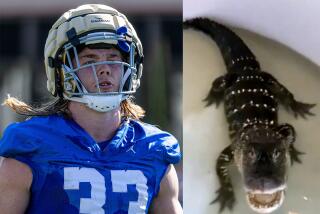Scientists Struggle to Preserve Gator’s Cousin : American Crocodiles Fighting for a Comeback
- Share via
MIAMI — Maintenance workers at Everglades National Park were surprised when they dug into a gravel pile and uncovered a clutch of crocodile eggs.
A rare American crocodile had taken to the gravel as a close approximation of a natural nesting mound.
The white eggs were carefully removed and incubated by a researcher. When the hatchlings were a week old they were released close to the makeshift nest.
The happy ending was assured by scientists intent on pushing the hulking loners back from the brink of extinction.
In the United States, crocodiles are found only in three breeding grounds south of Miami. Two of the 11 crocodile species in the world are man-eaters, but not the variety found in South Florida. Alligators are much more common than crocodiles, having proliferated in recent years after coming under federal protection. A hunting program was even initiated to help control the population.
Different Animals
“Most people don’t differentiate a crocodile from an alligator,” says park spokeswoman Pat Tolle. “It’s a big reptile with big feet and teeth. If you pin them down they might say they were dark or light or had a pointy snout.”
Seldom researched before it made the endangered species list in 1973, the American crocodile appeared headed for extinction. Only 20 nesting females were counted 10 years ago, but that number was up to 29 last year, giving scientists hope that the species is recovering. The total Florida population is believed to hover around 450.
Frank Mazzotti, a University of Florida wildlife biologist, suspects that one of the reasons the number of known breeding females has increased is that females are better at finding nests after 10 years of hunting.
Like the endangered Florida panther, crocodiles seem most at risk on the highway. Of 25 deaths investigated from 1971 to 1984, 19 were caused by man, including 10 killed by vehicles. Elevated roadbeds, bridges and culverts have been proposed to limit the highway death rate.
The crocodile once ranged as far north as Tampa Bay on the Gulf of Mexico and nested on Miami Beach. But the intrusion of man pushed the shy reptile to the southern edge of the Florida peninsula, breeding only at the park, the Crocodile National Wildlife Sanctuary on North Key Largo and 68 miles of cooling-water canals on a 10,000-acre preserve at the Turkey Point nuclear power plant south of Miami.
Visitors Barred
At the park, where roughly 60% of the crocodiles breed in their only natural setting, visitors have been barred since 1980 from a crocodile sanctuary that takes up perhaps 3% of the park, Tolle said.
Mazzotti and fellow crocodile researcher Paul Moler of the state game commission believe crocodiles are at least holding their own.
“The big problem is not crocodiles’ intolerance of people so much as it is people’s intolerance of crocodiles,” says Moler, who concentrates his research on North Key Largo. “They remain vulnerable and may always remain vulnerable because of the very limited area that’s available to them.”
Mazzotti is now studying nesting success and hatchling survival at the Turkey Point nuclear power plant.
Florida Power & Light Co. inadvertently came to the aid of the crocodiles by building an intricate 68-mile network of cooling-water canals at the plant on the Atlantic coast south of here. Pushed out of populated areas, the crocodiles found an ideal man-made substitute for the brackish mangrove swamp and beach habitat they prefer.
Alligators nest in mounds of vegetation, but crocodiles prefer mud or sand mounds 1 to 3 feet above the water line.
The females lay up to 80 eggs in late April or early May and the hatchlings crack through their white shells about 85 days later in late July or early August.
Mothers are quick to abandon their hatchlings. Four-day-old crocodiles have been found on their own.
Active at Night
Mazzotti described how field workers look for the 10-inch lizard-like creatures at night when crocodiles are most active.
“Their eyes look like bicycle reflectors,” he said. “We capture as many as we are able to by hand, in nets and specially made tongs.”
The hatchlings are weighed and measured and their tail scales are clipped according to a numerical code that serves as a lasting identifier. The youngsters are freed within an hour to avoid causing stress.
The crocodile temperament differs greatly from the sometimes combative alligator.
“I have literally taken a hatchling off the head of a female and there’s been no reaction,” Mazzotti said. “We neither scare the animal into flight nor into aggressive behavior.”
Raccoons, herons and blue crab, among others, prey on the 2-ounce hatchlings.
More to Read
Sign up for Essential California
The most important California stories and recommendations in your inbox every morning.
You may occasionally receive promotional content from the Los Angeles Times.












